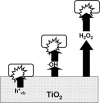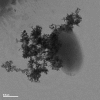Photocatalytic disinfection using titanium dioxide: spectrum and mechanism of antimicrobial activity
- PMID: 21523480
- PMCID: PMC7079867
- DOI: 10.1007/s00253-011-3213-7
Photocatalytic disinfection using titanium dioxide: spectrum and mechanism of antimicrobial activity
Abstract
The photocatalytic properties of titanium dioxide are well known and have many applications including the removal of organic contaminants and production of self-cleaning glass. There is an increasing interest in the application of the photocatalytic properties of TiO(2) for disinfection of surfaces, air and water. Reviews of the applications of photocatalysis in disinfection (Gamage and Zhang 2010; Chong et al., Wat Res 44(10):2997-3027, 2010) and of modelling of TiO(2) action have recently been published (Dalrymple et al. , Appl Catal B 98(1-2):27-38, 2010). In this review, we give an overview of the effects of photoactivated TiO(2) on microorganisms. The activity has been shown to be capable of killing a wide range of Gram-negative and Gram-positive bacteria, filamentous and unicellular fungi, algae, protozoa, mammalian viruses and bacteriophage. Resting stages, particularly bacterial endospores, fungal spores and protozoan cysts, are generally more resistant than the vegetative forms, possibly due to the increased cell wall thickness. The killing mechanism involves degradation of the cell wall and cytoplasmic membrane due to the production of reactive oxygen species such as hydroxyl radicals and hydrogen peroxide. This initially leads to leakage of cellular contents then cell lysis and may be followed by complete mineralisation of the organism. Killing is most efficient when there is close contact between the organisms and the TiO(2) catalyst. The killing activity is enhanced by the presence of other antimicrobial agents such as Cu and Ag.
Figures







References
-
- Akiba N, Hayakawa I, Keh ES, Watanabe A. Antifungal effects of a tissue conditioner coating agent with TiO2 photocatalyst. J Med Dent Sci. 2005;52(4):223–227. - PubMed
-
- Allen NS, Edge M, Verran J, Stratton J, Maltby J, Bygott C. Photocatalytic titania based surfaces: environmental benefits. Polym Degrad Stab. 2008;93(9):1632–1646. doi: 10.1016/j.polymdegradstab.2008.04.015. - DOI
-
- Amezaga-Madrid P, Silveyra-Morales R, Cordoba-Fierro L, Nevarez-Moorillon GV, Miki-Yoshida M, Orrantia-Borunda E, Solis FJ. TEM evidence of ultrastructural alteration on Pseudomonas aeruginosa by photocatalytic TiO2 thin films. J Photochem Photobiol B. 2003;70(1):45–50. doi: 10.1016/S1011-1344(03)00054-X. - DOI - PubMed
-
- Araña J, Herrera Melián JA, Doña Rodríguez JM, González Díaz O, Viera A, Pérez Peña J, Marrero Sosa PM, Espino Jiménez V. TiO2-photocatalysis as a tertiary treatment of naturally treated wastewater. Catal Today. 2002;76(2–4):279–289. doi: 10.1016/S0920-5861(02)00226-2. - DOI
Publication types
MeSH terms
Substances
LinkOut - more resources
Full Text Sources
Other Literature Sources
Medical
Molecular Biology Databases

